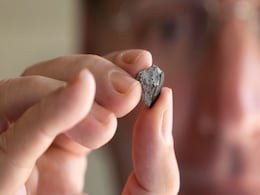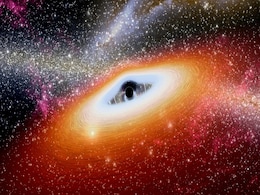Colossal Collisions
- All
- News
-

Cosmic Visitor: 4.56-Billion-Year-Old Meteorite Strikes into Georgia Home
- Thursday August 14, 2025
- Written by Gadgets 360 Staff
On June 26, 2025, a dazzling daytime fireball streaked over Georgia, captured by satellites and witnessed across multiple states. A surviving fragment smashed through the roof of a McDonough home, denting the wooden floor 14 feet below. Scientists at the University of Georgia analyzed about 23 grams of this ancient rock, determining it to be a 4.56...
-
 www.gadgets360.com
www.gadgets360.com
-

Supermassive Black Hole at the Centre of the Milky Way Is Spinning Unexpectedly
- Sunday September 15, 2024
- Written by Gadgets 360 Staff
Sagittarius A* (pronounced Sagittarius A Star), the supermassive black hole at the centre of the Milky Way, is spinning in an unusual way, and scientists now believe they may know why. Based on new data from the Event Horizon Telescope, researchers suggest that this cosmic giant likely merged with another black hole billions of years ago. This colo...
-
 www.gadgets360.com
www.gadgets360.com
-

Jupiter Still Suffering From 4.5 Billion-Year-Old Collision With Planet
- Friday August 16, 2019
- Science | Indo-Asian News Service
A colossal, head-on collision between Jupiter and a still-forming planet in the early solar system, about 4.5 billion years ago, has left Jupiter's core less dense and more extended that expected, say researchers.
-
 www.ndtv.com
www.ndtv.com
-

Colossal Cosmic Collision Alters Understanding Of Early Universe
- Thursday April 26, 2018
- World News | Reuters
Astronomers have detected the early stages of a colossal cosmic collision, observing a pile-up of 14 galaxies 90 percent of the way across the observable universe in a discovery that upends assumptions about the early history of the cosmos.
-
 www.ndtv.com
www.ndtv.com
-

Starstruck: Half of Universe's Stars are Orphans With No Galaxy
- Friday November 7, 2014
- Offbeat | Reuters
You can call them celestial orphans, stars flung out of their galaxies in colossal collisions that have occurred in space for billions of years. These forsaken stars may be far more common than anyone ever realized.
-
 www.ndtv.com
www.ndtv.com
-

Cosmic Visitor: 4.56-Billion-Year-Old Meteorite Strikes into Georgia Home
- Thursday August 14, 2025
- Written by Gadgets 360 Staff
On June 26, 2025, a dazzling daytime fireball streaked over Georgia, captured by satellites and witnessed across multiple states. A surviving fragment smashed through the roof of a McDonough home, denting the wooden floor 14 feet below. Scientists at the University of Georgia analyzed about 23 grams of this ancient rock, determining it to be a 4.56...
-
 www.gadgets360.com
www.gadgets360.com
-

Supermassive Black Hole at the Centre of the Milky Way Is Spinning Unexpectedly
- Sunday September 15, 2024
- Written by Gadgets 360 Staff
Sagittarius A* (pronounced Sagittarius A Star), the supermassive black hole at the centre of the Milky Way, is spinning in an unusual way, and scientists now believe they may know why. Based on new data from the Event Horizon Telescope, researchers suggest that this cosmic giant likely merged with another black hole billions of years ago. This colo...
-
 www.gadgets360.com
www.gadgets360.com
-

Jupiter Still Suffering From 4.5 Billion-Year-Old Collision With Planet
- Friday August 16, 2019
- Science | Indo-Asian News Service
A colossal, head-on collision between Jupiter and a still-forming planet in the early solar system, about 4.5 billion years ago, has left Jupiter's core less dense and more extended that expected, say researchers.
-
 www.ndtv.com
www.ndtv.com
-

Colossal Cosmic Collision Alters Understanding Of Early Universe
- Thursday April 26, 2018
- World News | Reuters
Astronomers have detected the early stages of a colossal cosmic collision, observing a pile-up of 14 galaxies 90 percent of the way across the observable universe in a discovery that upends assumptions about the early history of the cosmos.
-
 www.ndtv.com
www.ndtv.com
-

Starstruck: Half of Universe's Stars are Orphans With No Galaxy
- Friday November 7, 2014
- Offbeat | Reuters
You can call them celestial orphans, stars flung out of their galaxies in colossal collisions that have occurred in space for billions of years. These forsaken stars may be far more common than anyone ever realized.
-
 www.ndtv.com
www.ndtv.com







